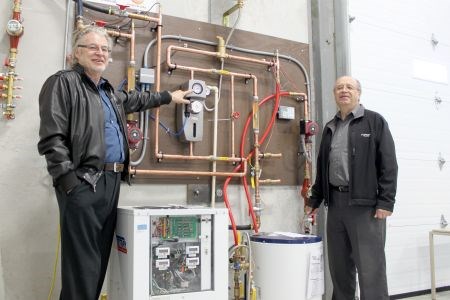When John Hood and Les Lisk initially developed their @Source-Energy Wall—a wall designed to generate energy by incorporating photovoltaic (PV) panels into its design—the energy readings were so high, they thought something had gone terribly wrong.
It turns out the system—which recovers heat from the panels and stores it in specially designed pipes for later use in heating the building—was not only working, it was performing better than the pair had theorized.
“We were bringing so much heat back up at nighttime because we were getting so much heat during the day,” Hood said. “It's way more successful than we figured.”
It's good news for the duo, both former educators at Cambrian College, which has patents on the technology and is in the process of its commercialization.
Three years ago, Hood and Lisk, the founding directors at Sudbury-based Renewable Resource Recovery Corp., came up with the idea for the @Source-Energy Pipe, a concrete pipe that operates on the principles of geothermal energy by recovering heat from water and the ground surrounding it.
But it was a trip to Toronto, where the bare, south-facing walls of the city's myriad buildings provided the inspiration for PV installation, that animated Hood and Lisk to design their newest system.
A precast, concrete wall panel with PV cells integrated into the face of the wall, the @Source-Energy Wall includes a thermal heat recovery system embedded in the concrete.
“Behind those solar panels, we have a heat extractor,” Lisk explained, noting the wall carries a rating of about R34. “So it's basically an array of copper tubing and we circulate a fluid through; we collect the heat from behind those panels.”
Removing the excess heat from behind the panels increases their efficacy and stores the heat, which would otherwise be wasted, for later use in heating the building. Any excess energy can then be sold to the provincial grid under Ontario's Feed-in Tariff (FIT) program.
“We have another patent on a heat exchanger, and it's buried underneath the complex in the concrete sewer pipes,” Lisk said. “We have a heat exchanger embedded in the walls of the pipe and, again, we circulate that fluid through and it stores excess heat in those pipes and the surrounding ground.”
During warmer months, the heat remains stored in the pipes, but can be retrieved for use during the winter months.
Hood and Lisk are currently testing out the technology at the Xstrata Nickel Sustainable Energy Centre at Cambrian College, where the pair hopes to monitor its performance in each of the four seasons. It is also being used as a teaching tool, with students conducting research on everything from solar panel performance to heat storage.
For that reason, excess energy generated isn't being sold back to the grid, but with a normal system Hood expects one could make about $8,000 a year from the FIT program. It would take an estimated seven and a half years to pay off the wall, after which, it would generate income for the owner.
“We estimated we would get equal heat energy as electricity,” Hood said. “But it appears we're getting a minimum twice as much heat energy, maybe even four or five times as much; we don't know yet. And that energy's normally just wasted.”
Now comes the tough part: marketing the system's potential. In Great Britain, a concrete pipe association has expressed interest, as has a large wastewater company, while in France, Hood and Lisk are hoping to generate buzz with the French government which is looking at a similar, but, in their estimation, less efficient system.
As energy and fuel costs rise, Hood predicts Canada will see a growth in demand for renewable energy systems that can mitigate some of the costs associated with home, commercial and industrial heating needs.
And with their @Source-Energy Wall system, Hood and Lisk plan to be ready.
“Up until now, people really didn't care that much in Canada and the U.S.; our energy was cheap,” Hood said. “As much as gas prices look like they're high, compared to Europe, we still have very low gas prices, so energy's been cheap. Now it's starting to get expensive.”




